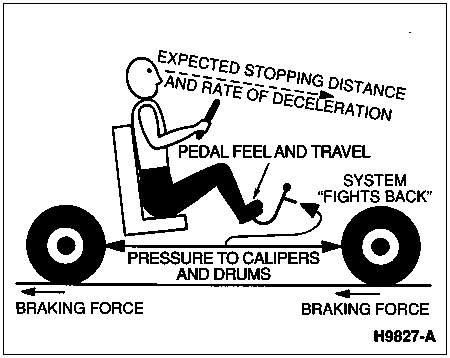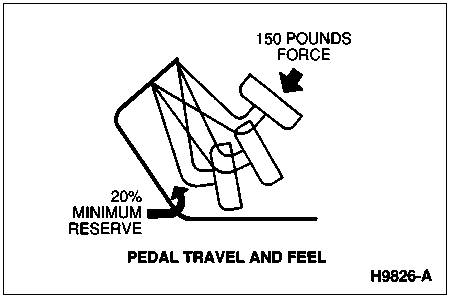Stopping Perceptions

Section 06-00: Brake System, Service | 1996 F-150, F-250, F-350, F-Super Duty Chassis Cab, Motorhome Chassis and Bronco Workshop Manual |
NOTE: Occasional brake squeal can be caused by environmental conditions such as cold ambient temperatures, heat, rain, snow, salt, mud, hot ambient temperatures or high humidity. This occasional squeal is not a functional problem and does not indicate any loss in brake effectiveness.
Verify the vehicle owner's complaint by performing the following inspection procedures.
Look for leaks. Clean the unit and remove the brake master cylinder filler cap (2162). Check the fluid level. Check the condition of the gasket.
With the engine (6007) running, apply 667 N (150 lbs.) force to the brake pedal (2455) and hold for ten seconds. If brake pedal height cannot be maintained for 10 seconds or the brake warning light comes on, service is required.
Visually examine front and rear tires and wheel assemblies for damage such as uneven wear, tread washouts, or sidewall damage. Make sure the tires are of the same size, type and, where possible, same manufacturer. Any tire or wheel (1007) that is damaged should be replaced. Refer to Section 04-04.
Wheels and tires must be cleared of any foreign matter, and tire pressures adjusted to the correct specifications listed in Section 04-04.
If tires exhibit uneven wear or feathering, the cause must be corrected. Check steering and suspension components for damage/wear and, if necessary, check and adjust steering alignment. Refer to Section 04-00.
Check hydraulic hoses and tubes for leaks, cracks, chaffing, and distortions. The fasteners that hold these components in place should also be checked.
NOTE: Do not pry under or otherwise disturb the dust boot. This may destroy a very important seal. If there is leakage, it will find its way around the dust boot.
With the brake drum (1126) removed, check for loose or worn parts. Check the rear wheel cylinder (2261) for leakage around the dust boot.
Check for proper installation, leakage, caliper slide lubrication and excessive wear along caliper supports.
Test the instrument cluster warning light.
Check that the link from the brake load sensor proportioning valve (2B547) to the frame (5005) is properly connected. The brake load sensor proportioning valve is calibrated for the particular vehicle it is installed on. If modifications are made to the rear suspension system on that vehicle, the brake load sensor proportioning valve will not work properly and must be deactivated.
Isolate ABS.
To check for premature RABS activation, thoroughly check the base brake system. If the base brake system checks out and there is still premature RABS activation, there are several areas to take a close look at:
Road Test
A road test should be performed to compare actual vehicle braking performance with the performance standards expected by the driver. The ability of the test driver to make valid comparisons and detect performance deficiencies will depend on experience.
The driver should have a thorough knowledge of brake system operation and accepted general performance guidelines in order to make good comparisons and detect performance problems.
An experienced brake technician will always establish a route that will be used for all brake diagnosis road tests. The road selected will be reasonably smooth and level. Gravel or bumpy roads are not suitable because the surface does not allow the tires to grip the road equally. Crowned roads should be avoided because of the large amount of weight shifted to the low set of wheels on this type of road. Once the route is established and consistently used, the road surface variable can be eliminated from the test results.
The road test should begin with a general brake performance check. With the customer's description as a guide, the brake system should be tested at different vehicle speeds using both light and heavy brake pedal pressure. To determine if the problem is in the front or rear braking system, the service brake pedal is used first, then the parking brake. If the condition (i.e., pull, vibration, pulsation) occurs only with the parking brake, the problem is in the rear system. If the condition occurs when the service brake pedal is pressed, the problem is in the front system.
However, other causes such as wheel or suspension problems are not eliminated by this test.
Locking the brakes and sliding the tires should be avoided. Locked brakes and sliding tires do not indicate brake efficiency: A heavily braked and turning wheel will stop the vehicle in less distance than locked brakes. If the problem becomes evident during this check, it should be determined if it fits the description given before the road test. If the problem is not evident, an attempt should be made to duplicate the condition using the information from the description.
If a concern exists, the Symptom Chart in this section should be used, in order to isolate it to a specific sub-system and condition description. From this description, a list of possible causes can be used to further narrow the cause to a specific component or condition.
A key factor in evaluating brake concerns is the deceleration rate. This varies from vehicle to vehicle and with changes in operating conditions. It is evident how well the brakes on a particular vehicle are working after just a few applications.
Stopping Distance Test
Mark out or find a driving lane that is 3.7m (12 ft.) wide. Place two markers along this lane, 7.5m (25 ft.) apart. At a speed of 32 km/h (20 mph), drive down the center of the lane and apply the service brakes when you reach the first marker. Observe whether the vehicle comes to a smooth stop before the second marker. Also note whether it pulled to the right or left and whether it went beyond the 3.7m (12 ft.) width. For vehicles under 4500 kg (10,000 lbs.), a commonly accepted standard is a smooth stop within 7.5m (25 ft.), while staying within the lane. For vehicles over 4500 kg (10,000 lbs.), the distance is 11m (35 ft.).
Pedal Reserve Test
On vehicles with vacuum power brakes and with the engine running, apply 667 N (150 lbs.) force and observe the extent of pedal travel. There should be at least 20% reserve travel distance available.
NOTE: If the vehicle is equipped with a hydraulic power brake booster (2005), apply normal foot force that is no more than 266 N (60 lbs.).

The "Rolling Skid"
The ABS system is designed to sense the RAPID deceleration rate of a wheel. This is what warns of possible lockup. Some tires have high peak traction which tends to fall off rapidly. When a tire has this characteristic, the ABS can easily perform as designed. When increasing the braking force, the tires rapidly decelerate, and at the appropriate point, the ABS kicks in at the wheel or axle that needs reduced pressure. Brake pedal pulsations can be felt, and on 4WABS the pump motor can be heard.
Tires with a tendency to develop peak traction which then falls off more slowly may slip some as they decelerate (sometimes referred to as a "rolling skid"). This was a typical characteristic of bias belted tires. This condition may cause the ABS system not to activate because the wheel isn't fully locking up. There may, however, be considerable squealing and smoking of the tires, and sometimes even skid marks. This is a concern the customer may report.
Have the customer take you for a drive to demonstrate. Observe how the driver activates the brakes. Before beginning the test, adjust the outside rearview mirrors so you can observe the rear wheels.
Have the owner apply the brakes normally during a hard stop. Ford recommends speeds of no more than 24 km/h (15 mph) for this test. If you feel the ABS activate, rolling skid isn't the problem.
If the ABS doesn't activate, have the driver increase the pressure until they squeal and smoke. Hold in this position. Observe rearview mirrors for evidence of smoke. It is also helpful to have an assistant standing nearby who can watch the wheels from a better angle during the test.
Check to see if the wheels continue to rotate for the duration of the stop.
NOTE: Some initial, momentary wheel lockup is permissible during this test.
Finally, see if increasing the pressure even more will cause the ABS to activate. If it does, the vehicle is experiencing the slow drop-off from peak traction discussed above.
This last step, applying extra pressure, is very important to the diagnosis. Many drivers back off on the brakes when they hear the squeal because they think, and understandably so, that a wheel or wheels are locking up. Correcting this problem may mean explaining that the system is functioning fine and the wheels are not locking up.
When diagnosing RABS concerns on a 4-wheel drive vehicle, remember that the front and rear drivetrains are mechanically locked together in 4-wheel drive. If the front wheels turn, the rear wheels turn. If the front wheels lock up, the rear wheels lock up. The RABS can't prevent lockup in the rear when the front brakes are applied hard enough to cause lockup on low-traction surfaces.
Brake Pedal Feel and Stopping Distance
A combination of conditions indicates whether brakes are working properly: The feel of the brake pedal, how rapidly vehicle slows down and distance travelled before stopping.
Customers often report brake problems in terms of brake pedal feel. "My brakes feel spongy" or "The brake pedal went to the floor" or "The brakes feel hard and I have to apply much more force than usual" are all possible customer complaints. These complaints are often accompanied by reports that the vehicle "Just didn't stop the way it should." These simple complaints may indicate problems that are much more complex to diagnose and correct.
Stopping Perceptions
Understanding brake feel and stopping distance is a challenge because different brake systems have a different feel and a different braking response. Feel is the result of several factors, described below.
Design
Brake feel will vary from vehicle to vehicle, even of the same design depending on how the vehicle is equipped.
Operation
How the vehicle is used may also change the feel of the brakes. Factors such as loading, trailer towing and operating on steep grades or gravel roads can all affect the feel of the brakes.
Pedal Force and Travel
The amount of force applied, combined with the amount of brake pedal travel will affect the feel and stopping response. Some drivers are stronger than others and can force the brake pedal down further.
Spring or Give in the System
The disc brake calipers (2B120) flex a little as force is applied, flexible hoses swell a little under pressure, and shoe return springs are extended. The combination of these and other points where the system gives a little results in a "springiness" that "fights back" against the hydraulic pressure. This "fighting back" is felt through the brake pedal. As parts of the system become worn or corroded, this "fighting back" feel may change.
The Vehicle That Keeps Coming Back
If you get a vehicle that has been brought in for brake service frequently, take a close look at the service history. How long did that vehicle go before its first brake service? What has happened since? If components have been replaced, are they the correct parts? Recurring problems can be the result of some mistake made earlier in the service history.
Engine-Drive Pump Belt Check, F-Super Duty
The power steering belt tension is automatically adjusted. Refer to Section 03-05 for power steering belt tension inspection.